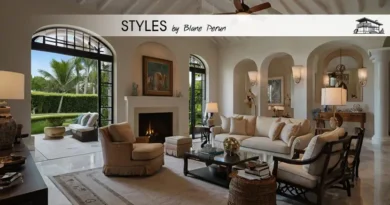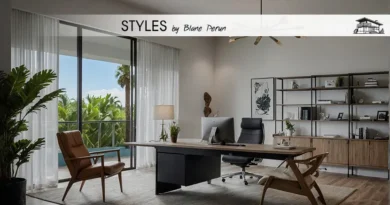Victorian Style
Embracing Elegance: The Timeless Charm of Victorian Interior Design
Diving into the realm of Victorian Interior Design is like stepping into a world where every detail tells a story, and every room holds a secret waiting to be unraveled. This design style, hailing from the Victorian era, is known for its intricate patterns, ornate furnishings, and a flair for the dramatic that can turn any space into a testament to timeless elegance. It’s not just about filling a room with antique pieces; it’s about weaving a tapestry of history, art, and culture that reflects the grandiosity of an era long past but never forgotten.

The Pillars of Victorian Aesthetics
Historical Roots and Inspirations
Victorian Interior Design draws its breath from the depths of the 19th century, a time when the Industrial Revolution was at its zenith, and the British Empire was in full bloom. The design encapsulates the spirit of an era where technological advancements and a burgeoning middle class reshaped society. This period saw a fusion of Gothic, Rococo, and Neoclassical styles, giving rise to a distinctive aesthetic marked by elaborate woodwork, sumptuous fabrics, and a palette that favored deep, rich tones.
Artistry in Furniture and Decor
A hallmark of Victorian design is the emphasis on heavy, ornate furniture that commands attention. Pieces like the chaise lounge, the ottoman, and the sideboard, often made from dark woods such as mahogany and walnut, are quintessential. These items were not merely functional but were imbued with artistry, featuring elaborate carvings and inlays that spoke of the owner’s status and taste.
The Victorian Palette: Colors and Textures
The Richness of Color
In Victorian homes, color schemes were anything but subdued. Deep reds, greens, blues, and purples adorned walls, draperies, and upholstery, creating a backdrop of warmth and depth. This was a time when synthetic dyes came into being, allowing for a broader and more vibrant spectrum of colors, which homeowners embraced with zeal, reflecting their optimism and the era’s exuberance.
Embracing Textural Depth
Texture played a pivotal role in Victorian interiors, with a preference for heavy fabrics like velvet, damask, and brocade. These materials were often used in window treatments, upholstery, and wall coverings, adding a layer of opulence and comfort. Wallpaper, especially, saw a surge in popularity, with intricate floral and geometric patterns that added visual interest and depth to the rooms.
Lighting and Ornamentation: The Finishing Touches
The Glow of Gaslight and Candles
In the Victorian era, the advent of gas lighting brought a new dimension to interior design. Chandeliers and sconces became focal points, not just for their illumination but for their ornate designs, often featuring glass and crystal elements that reflected the light beautifully. Candles, too, remained a staple, housed in elaborate candelabras, adding a warm, flickering light that enhanced the room’s ambiance.
A Tapestry of Accessories
Accessories in Victorian Interior Design are not mere afterthoughts; they are integral to the narrative. From intricately framed paintings and photographs to collections of books, china, and curios, every item was a piece of the puzzle that completed the picture of Victorian life. Ornate mirrors, vases filled with fresh flowers, and decorative items from around the globe were commonly displayed, showcasing the homeowner’s wealth and worldly interests.
In wrapping up our journey through the enchanting world of Victorian Interior Design, it’s clear that this style is more than just an aesthetic choice; it’s a homage to an era that celebrated artistry, innovation, and the beauty of detail. Whether you’re an aficionado of antique charm or a modern homeowner looking to inject a touch of historical grandeur into your space, Victorian design offers a palette rich with inspiration.

FAQs on Victorian Interior Design
What defines Victorian Interior Design?
Victorian Interior Design is characterized by its ornate and elaborate aesthetic, drawing from Gothic, Rococo, and Neoclassical influences. It features dark, rich color palettes, heavy and intricately designed furniture, and a wealth of decorative details, from ornate wallpapers to lush textiles and an abundance of accessories.
How can I incorporate Victorian design elements into a modern home?
Incorporating Victorian elements into a modern home can be achieved by integrating key pieces and characteristics like ornate furniture, rich color schemes, and decorative accessories. Start with a focal piece, such as a Victorian-style sofa or armchair, and build your room around it with complementary colors and textures. Adding wallpaper or textiles with Victorian patterns can also help bridge the gap between old and new.
What types of materials and fabrics are commonly used in Victorian Interior Design?
Victorian design often features dark woods like mahogany and walnut for furniture. Fabrics are typically lush and luxurious, with velvet, damask, brocade, and heavy silks being popular choices for upholstery, draperies, and wall coverings. Wallpaper often features intricate floral or geometric patterns, adding to the overall richness of the design.
How important are accessories in Victorian Interior Design?
Accessories play a crucial role in Victorian interiors, adding layers of complexity and interest. From ornate mirrors and frames to collections of books, china, and decorative items, these accessories help convey the wealth, taste, and interests of the homeowner, while also contributing to the overall opulence and detailed aesthetic of the space.
Can Victorian Interior Design be adapted to small spaces?
Absolutely! While Victorian design is known for its richness and depth, it can be adapted to smaller spaces by choosing a few key elements to focus on. Opt for one or two pieces of statement furniture, use rich colors and textures in moderation, and select decorative accessories that add Victorian flair without overwhelming the space.





